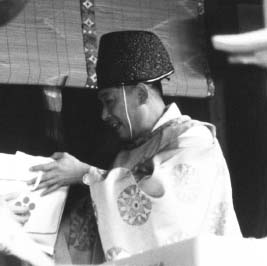ShintoSigns and Symbols |
What signs or symbols distinguish Shinto ritual specialists? |
Shinto priests wear distinctive garb (called shozoku) modeled on courtly fashions from the Heian period, the days when Japan’s capital was in Kyoto. Ritual robes are of several types. They wear a kimono and a pair of very full-cut pants underneath. Outer garments originally indicated courtly rank with various colors (robin’s-egg blue, red, purple, yellow, and light green), but now a priest’s rank is indicated by either pale blue, black, or red. Outer garments have very wide flowing sleeves and extend down to the feet. For ordinary ceremonies priests wear a white silk vestment called a karinigu (“hunting cloak,” a name from medieval times). With the simpler garments for ordinary duties, priests wear a plain roundish hat called eboshi, reserving a taller and more elegant version called kanmuri for high ritual occasions. High-ranking priests wear polished wooden shoes for rituals, and their subordinates wear thong sandals of wood. During all ceremonies, officiants carry a slender, tapered slab of wood called the shaku in the right hand, similar to the one seen in images of Chinese ancestor figures. Since even a layperson sometimes leads rituals and wears these same garments, they do not function like a “habit” to distinguish priests from laity. When not performing their shrine duties, Shinto priests wear ordinary street clothes. Shrine maidens (miko) wear a white kimono top and a vermillion or scarlet split skirt, only when they are performing shrine duties. Musicians, whether priests or not, also wear similar versions of Heian court fashion during ceremonies.

A Shinto priest, wearing the less formal headgear called the eboshi, receives and arranges offerings in preparation for a shrine festival. The lanterns are decorative and symbolic items found in great numbers around most larger shrines.
